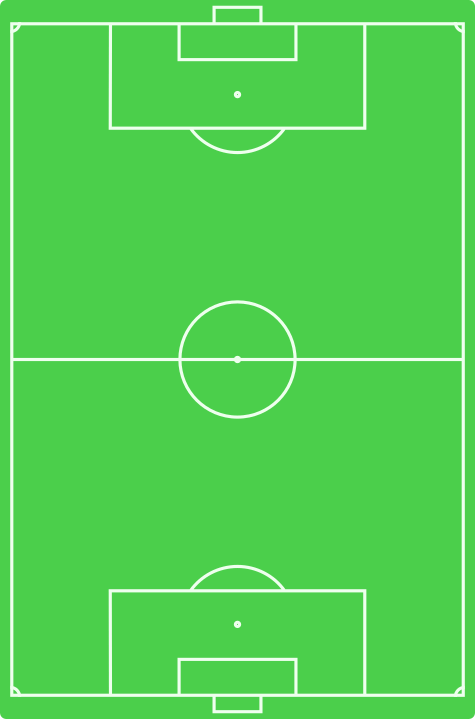Derby County F.C.
 | ||||
| Full name | Derby County Football Club | |||
|---|---|---|---|---|
| Nickname(s) | The Rams | |||
| Founded | 1884 | |||
| Ground | Pride Park Stadium | |||
| Capacity | 33,597 | |||
| Owner | Mel Morris | |||
| Chairman | Mel Morris | |||
| Manager | Frank Lampard | |||
| League | Championship | |||
| 2017–18 | Championship, 6th of 24 | |||
| Website | Club website | |||
|
| ||||
Derby County Football Club (/ˈdɑːrbi
Notable for being one of the twelve founder members of the Football League in 1888, Derby County is one of only ten clubs to have competed in every season of the English football league system and, in 2009, was ranked 137th in the top 200 European football teams of the 20th century by the International Federation of Football History & Statistics.[1]
The club was founded in 1884 by William Morley, as an offshoot of Derbyshire County Cricket Club; it has spent all but four seasons in the top two divisions of English football. Its competitive peak came in the 1970s when it twice won the First Division and competed in major European competitions on four separate occasions, reaching the European Cup semi-finals as well as winning several minor trophies. Additionally, the club was a strong force in the interwar years, winning the 1945–46 FA Cup.
The club's home colours have been black and white since the 1890s. The team gets their nickname, The Rams, to show tribute to its links with the First Regiment of Derby Militia, which took a ram as its mascot. Additionally adopting the song "The Derby Ram" as its regimental song.[2]
History
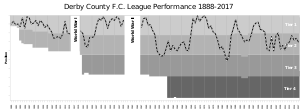
Beginning and early success
Derby County F.C. was formed in 1884 as an offshoot of Derbyshire County Cricket Club in an attempt to give players and supporters a winter interest as well as secure the cricket club extra revenue. The original intention was to name the club "Derbyshire County F.C." to highlight the link, though the Derbyshire FA, formed in 1883, objected on the grounds it was too long and therefore would not have been understood by the fans who may mistake it for a Derbyshire FA team. Playing their home matches at the cricket club's Racecourse Ground, 1884–85 saw the club undertake an extensive programme of friendly matches, the first of which was a 6–0 defeat to Great Lever on 13 September 1884. The club’s first competitive match came in the 1885 FA Cup, where they lost 7–0 at home to Walsall Town.
Arguably the most important match in the club's history came in the following season's FA Cup, when a 2–0 victory over Aston Villa, already an emerging force in English football, helped establish Derby County on the English football map, helping the club to attract better opposition for friendlies and, in 1888, an invitation into the inaugural Football League. The opening day of the first ever league season was 8 September 1888, when Derby came from 3–0 down away to Bolton Wanderers to win 6–3, though the club ultimately finished 10th out of 12 teams. In 1891, they absorbed another Derby club, Derby Midland, which had been a member of the Midland League, leaving them as Derby's sole professional football club. Steve Bloomer, generally considered to be Derby County's best-ever player, joined the club in 1892. In 1895, the club moved to a new stadium, the Baseball Ground (so called because it was previously used for baseball), which became their home for the next 102 years. It was then that the club adopted their now traditional home colours of black and white.
Although Derby were inconsistent in the league, they finished as runners-up to Aston Villa in 1896, as well as achieved a number of third-place finishes. They were a strong force in the FA Cup, appearing in three finals in six years around the turn of the 20th century, though lost all three, in 1898 (3–1 to Nottingham Forest),[3] 1899 (4–1 to Sheffield United)[4] and 1903 (6–0 to Bury).[5]
Edwardian and interwar era
In 1906, Steve Bloomer was sold to Middlesbrough due to financial constraints, and Derby subsequently suffered its first ever relegation the following season,[6] but under Jimmy Methven's management, they re-signed Bloomer and regained their First Division place in 1911.[6] In 1914, they were again relegated, but instantly won the Second Division to earn promotion,[6] though World War I meant they had to wait until 1919 to play First Division football again. After two seasons, they were relegated yet again in 1921. However, the appointment of George Jobey in 1925 kick-started a successful period for the Rams and, after promotion in 1926,[6] the club became a formidable force, with high finishes from the late 1920s and all through the 1930s,[6] including finishing as runners-up twice.
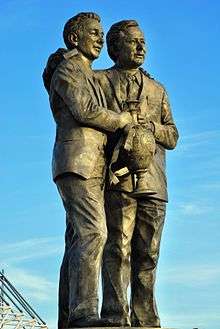
Derby were one of several clubs to close down after the outbreak of World War II but restarted in the early 1940s, in part due to the persistence of Jack Nicholas and Jack Webb. Aided by the recruitment of Raich Carter and Peter Doherty, who had both been stationed in Loughborough during the war, Derby were one step ahead of the opposition when competitive football resumed with the 1946 FA Cup and won their first major trophy with a 4–1 victory over Charlton Athletic.[7]
Post-war success and decline
The league restarted the following season after a break due to World War II and, under the management of Stuart McMillan, as well as twice breaking the British transfer record to sign Billy Steel and Johnny Morris to replace Carter and Doherty, finished fourth and third in the 1948 and 1949 seasons respectively, before a steady decline set in and the club was relegated in 1953, after nearly 30 years in the top flight, and again in 1955 to drop to the third tier of English football for the first time in their history.[6] Harry Storer led Derby back into the second tier at the second attempt in 1957, though the club progressed no further over the next decade under either Storer or his successor, former Derby player Tim Ward.
Brian Clough era
In 1967, Brian Clough and Peter Taylor took over and led them to their greatest glory. Having clinched the influential signing of Dave Mackay, Derby were promoted to the First Division in 1969, finished fourth in 1970,[6] were banned from competing in Europe due to financial irregularities in 1971 and won their first ever Football League Championship in 1972.[6] Though Derby did not retain their title the following season, they did reach the semi-finals of the European Cup, where they lost to Juventus. Clough's frequent outspoken comments against football's establishment eventually led to him falling out with the board of directors at the club, and Clough and Taylor left in October 1973. Such was their impact on the club that, 37 years later, a 9 ft (2.75 metres) bronze statue of the pair was erected outside Pride Park in commemoration of their legacy.[8]
Success and decline after Clough
Despite the departure of Clough and Taylor, Derby's League success was repeated in the 1974–75 season when they won the title under successor Dave Mackay, who had been a player under Clough when they had returned to the top flight in 1969. However, Derby's form declined towards the end of the 1970s and they went down to the Second Division in 1980 after a string of managers, including former Manchester United boss Tommy Docherty, unsettled the club trying desperately to maintain its place at the top of the First Division. Though they challenged well in their first season, Derby were soon hit hard by rising debts, falling attendances and dismal performances. Peter Taylor returned to the Baseball Ground as manager in early 1983 and kept Derby up that season, but he retired a year later just before Derby's relegation to the Third Division for only the second time in their history. However, Derby did manage to avoid going out of business, and they were soon under the ownership of wealthy businessman Robert Maxwell.
1980s revival
After relegation to the Third Division in May 1984, the club appointed Arthur Cox as manager. Although they missed out on promotion in Cox's first season as manager, they then won back-to-back promotions and were back in the First Division for the 1987–88 season, with attendances also rising as the club's on-the-field fortunes and financial position improved. The financial backing of new chairman Robert Maxwell saw stars such as Peter Shilton, Mark Wright, Dean Saunders, Trevor Hebberd and Ted McMinn brought to the club and they finished fifth in the 1988–89 season. However, English clubs were banned from European competition at the time following the Heysel Stadium disaster and so the Rams missed out on a place in the UEFA Cup.
End of the century
A lack of any further investment from Maxwell quickly led to a decline, culminating in relegation back to the Second Division in 1991. At this time, local newspaper businessman Lionel Pickering became the majority shareholder of the club, taking control just before Maxwell's death in November 1991.
In 1992, Derby County paid £2.5 million for Notts County central defender Craig Short, at the time – and for five years afterwards – the most expensive player to be signed by a club outside the top flight, and indeed one of the highest fees paid by any English club for a player at the time. Other expensive signings included strikers Tommy Johnson and Marco Gabbiadini.
Cox's resignation as manager in October 1993 saw the appointment of legendary former player Roy McFarland as manager. Derby reached the final of the Division One playoffs that season, but were beaten by local rivals Leicester City. McFarland was sacked a year later after Derby missed out on the playoffs, and his replacement was Jim Smith – a manager whose track record at his previous clubs included four promotions and an FA Cup semi-final appearance.
Although the 1995–96 season started slowly, the signing of sweeper Igor Štimac in the early autumn proved pivotal. Smith guided the Rams to a second-place finish and the Premier League, now the top flight of English football. During that season, it was announced Derby would be leaving the Baseball Ground after more than 100 years to move into a new all-seater stadium, following earlier plans to develop the Baseball Ground as a 26,000-seat stadium.
After finishing in 12th place in their first season back into the top flight, the club left the Baseball Ground, its home of 102 years, to move into the new 33,597-seat Pride Park Stadium for the 1997–98 season. The Baseball Ground was demolished six years later and a memorial was eventually erected in memory of its role in Derby city history.[9]
21st century
The club settled well into its new home as it recorded back-to-back top-ten finishes for the first time since their 1970s peak, before a sudden decline at the turn of the millennium saw three years of struggle. Smith resigned to be replaced by former players Colin Todd, who lasted just three months, and John Gregory before the Rams were relegated after a six-year stay in the top flight, in 2002.
Derby County's relegation saw the club enter a serious financial crisis, which forced them to sell many key players. Gregory was later suspended from his managerial duties over alleged misconduct and former Ipswich Town boss George Burley was brought in. The club was put into receivership then sold in October 2003 for £3 to a group led by Jeremy Keith. After finishing 20th in the 2003–04 season, a dramatic improvement in the 2004–05 season saw Derby finish fourth in the Championship, qualifying for a promotion play-off spot, though they lost in the semi-finals to Preston North End. Soon afterwards, Burley resigned citing differences between himself and the board. He was replaced by Bolton Wanderers first team coach Phil Brown. In January 2006, Brown was sacked after a poor run of results. Terry Westley, the academy coach at the time, took over first team duties until the end of the season and saved Derby from relegation.
In April 2006, a consortium of local businessmen led by former vice-chairman Peter Gadsby purchased the club, reducing its debt and returning Pride Park Stadium to the club's ownership in the process. In June 2006, former Preston North End boss Billy Davies was appointed Derby County's new permanent manager. In his first season, Davies took Derby to the Championship play-offs, where they beat Southampton on penalties in the semi-finals before defeating West Bromwich Albion 1–0 with a second-half Stephen Pearson goal at the new Wembley Stadium to secure a return to the Premier League and the associated £60 million windfall. In October 2007, Peter Gadsby stepped down as chairman to be replaced by former Hull City owner Adam Pearson, who immediately began searching for investment from overseas.[10] After a poor start to the season, manager Billy Davies left by mutual consent in November.[11] He was succeeded by Paul Jewell,[12] who failed to save the club as Derby suffered the Premier League's earliest ever relegation, in March,[13] recorded the Premier League's lowest-ever points total,[14] and equalled Loughborough's 108-year Football League record of going through an entire season with only one win, which occurred during the 1899–1900 season when Loughborough finished bottom of the Second Division. In January 2008, Derby was taken over by an international investment group led by General Sports and Entertainment, with Pearson remaining as de facto chairman.[15]
Derby's match at home to Sheffield United on 13 September 2008 generated much media coverage as it was approaching a year since Derby's last league win, a run which saw the club break the English league record for most matches without a win. Just four days short of the anniversary of the 1–0 victory over Newcastle United, Rob Hulse scored against his former club as Derby ran out 2–1 winners, earning Paul Jewell his first league win as Derby boss at his 27th attempt. Despite taking the club to the League Cup semi-final, the club's first major cup semi-final since 1976, where Derby lost 4–3 to Manchester United over two legs, Jewell resigned as manager in December 2008 after a run of just 2 wins in 11 matches.[16] He was replaced by Nigel Clough,[17] son of former manager Brian Clough. Nigel Clough led the club to 18th place and safety. After two seasons that saw the club finish in the bottom half of the table, Derby finished the two subsequent seasons in 12th and 10th place. Clough was replaced by Steve McClaren in September 2013; McClaren led the club to a 3rd-place finish in the 2013–14 Championship season, but lost the play-off final to Queens Park Rangers. Derby failed to finish in the play-offs the following season, which saw McClaren sacked as local-businessman Mel Morris assumed control. Morris oversaw a level of spending unprecedented in Derby's history over the following three years, breaking the clubs transfer record four times, but also saw an unprecedented managerial turnover as went through six managers between June 2015 and May 2017. In this three-season period, Derby qualified for the play-offs twice, but failed to get past the semi-finals on both occasions.
Club crest and colours
Crest
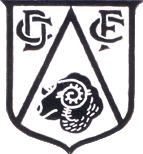
Like most old football clubs, Derby County did not initially have any badge displayed on their shirts. Their first badge was introduced in 1924. The badge consisted of a circular shield split into three equally sized sections, representing the club, its fans and the area, all containing items traditionally associated with the city of Derby: a Tudor rose and a crown in one section, a buck in a park in the second and a ram's head in the final section. The badge was worn on the players' shirts for just two seasons before they reverted to plain shirts.
By 1934, another badge had been introduced. This time it was a traditionally shaped shield, again with three sections. The buck in the park had been removed and the rose and the crown had been split up and now occupied a section each. The ram's head also remained and was now given the largest section of the shield. The badge never appeared on the players' shirts. The shield was modified in 1946 when the rose and crown were removed and replaced with the letters "DC" (Derby County) and "FC" (Football Club) respectively. The badge, right, was featured on to the player's shirts from its introduction onwards, though the ram's head on its own was used from the late 1960s (the full shield, however, remained the club's official logo).

A new club badge was introduced in 1971, featuring a more modern design that, with modifications, is still in use. The badge was initially consisted of a stylised white ram facing left. The badge was first modified slightly in 1979 to include the text "Derby County FC" under the ram (though the ram remained on its own on away kits). In 1982, the ram turned to face to the right and the text under it was removed. The ram was surrounded by a wreath of laurel and the text "Centenary 1984–1985" was printed underneath for the club's centenary season. The laurel was removed and the text reading "Derby County FC" returned from the next season. In 1993, the ram faced left again and the text was removed once more. From 1995, the ram faced right and was enclosed in a diamond, with a gold banner reading "Derby County FC" underneath and the text "1884" (the year of the club's foundation) underneath that. The design was changed again in 1997 (see left): the ram faced now left and the golden banner now simply read "Derby County"; the diamond and year of formation were removed.
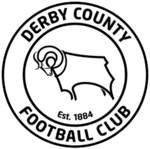
A decade later, in 2007, the badge was modified again with the ram still facing left and the text "Est. 1884" now in the middle of a circular frame featuring "Derby County Football Club" in gold lettering, with the colours being modified to the club colours of black and white in 2009 (see top of page). In July 2012, the club announced its intention to show only the iconic ram on future shirts, rather than the full club logo. In July 2013, this traditional ram became the club's full logo again.
Colours
Derby County's original colours (right) were amber, chocolate and blue, though by the 1890s the club had adopted its now traditional colours of black and white, which are still in use today. In the 1970s and 1980s, colours for home matches were white shirts with small blue or red touches (on the club badge or shirt makers insignia), blue shorts and socks that were blue, red, white or a combination of the three.[18] The colours of away kits have varied widely, and although they are usually yellow/gold or blue, the colour for the away kit for the 2008–09 season was fluorescent green.[19] The club also introduced a surprise third kit in August 2008. Similar in design to the club's away kit of the 1970s, with blue and white stripes and reminiscent of the Argentina national team strip, the style was re-introduced following feedback from fans who said it was one of their favourite kits from the club's past.[20]
| Period | Kit Sponsor | Shirt Sponsor |
|---|---|---|
| 1973–1979 | Umbro | None |
| 1979–1980 | Le Coq Sportif | |
| 1980–1981 | British Midland | |
| 1981–1982 | Patrick | |
| 1982–1984 | Patrick | |
| 1984–1985 | Admiral | Bass Brewery |
| 1985–1986 | OSCA | |
| 1986–1987 | Sportsweek | |
| 1987–1992 | Umbro | Maxwell Communications |
| 1992–1993 | Auto Windscreens | |
| 1993–1994 | Bukta | |
| 1994–1995 | Rams Pro Wear | |
| 1995–1998 | Puma | Puma |
| 1998–2001 | EDS | |
| 2001–2005 | Erreà | Marston's Pedigree |
| 2005–2007 | Joma | Derbyshire Building Society |
| 2007–2008 | Adidas | |
| 2008–2010 | Bombardier | |
| 2010–2012 | buymobiles.net | |
| 2012–2014 | Kappa | |
| 2014–2017 | Umbro | Just-Eat |
| 2017–2018 | Avon Tyres | |
| 2018–Present | 32Red | |
Club mascot
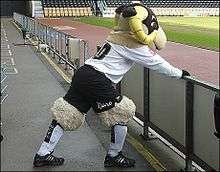
Derby's mascot is a ram named Rammie. Rammie is a full-time employee of the club who also works to maintain the club's links with fans and the East Midlands in general, such as school visits to promote literacy and charity events.[21][22] Rammie originally emerged as a more friendly option to the club's traditional links with the British Army and the Mercian Regiment in particular.
Rammie was the first full-time mascot in British football.[23][24] Rammie's traditional activities include penalty shoot-outs with members of the crowd at half-time, with Rammie as goalkeeper, and warming the crowd up before the match and encouraging the Derby fans during matches. Rammie is a very popular figure amongst Rams fans[25][26] and, in 2005, released his first DVD, which features the character reading from Aesop's Fables in the Derbyshire countryside.[23]
Shortly thereafter, Rammie was joined by a female equivalent, named Eweie. However, Eweie did not last very long at Pride Park, and took a reported "vacation" to the United States. She returned from a ten-year exile on 3 October 2015 at a home match against Brentford.[27]
Stadium
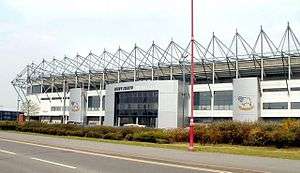
As an offshoot of Derbyshire County Cricket Club, Derby County’s first home stadium was County Cricket Ground, also known as the Racecourse Ground, where the club played its league and FA Cup matches between 1884 and 1895. Although the ground itself was good enough to hold the first FA Cup final match outside London, when Blackburn Rovers beat West Bromwich Albion 2–0 in the 1886 FA Cup final replay[28] and a full England international, disputes over fixture clashed between the football and cricket clubs meant that when the opportunity to play at Sir Francis Ley's Baseball Ground arose, the club accepted.[29]
Commonly referred to amongst supporters as "the BBG", the club moved to the Baseball Ground in 1895 and remained there for the next 102 years, despite opportunities to move in the 1920s and 1940s.[29][30] Derby had already played there, a 1–0 win over Sunderland during the 1891–92 season, as an alternative venue after a fixture clash at the County Ground. At its peak during the late 1960s, the ground could hold around 42,000 – the club’s record attendance achieved following the opening of the Ley Stand with a 41,826 crowd watching a 5–0 defeat of Tottenham Hotspur on 20 September 1969.[29] From this peak, the continued addition of seating saw the capacity drop over the next 15 years to 26,500 in 1985.
Following the Taylor Report in 1989, and the legal requirement for all seater stadia, the ground's capacity dwindled to just 18,500 by the mid-1990s, not enough for the then ambitious second tier club. Despite initially hoping to rebuild the Baseball Ground to hold 26,000 spectators, and rejecting the offer of two sites elsewhere in Derby, then-chairman Lionel Pickering announced in February 1996 the intention to move to a new, purpose built stadium at the newly regenerated Pride Park, with the last ever first team game at the Baseball Ground being in May 1997, a 1–3 home defeat to Arsenal, though it continued to host reserve matches until 2003. Derby's new ground, named Pride Park Stadium, was officially opened by the Queen on 18 July with a friendly against Italian club Sampdoria following on 4 August.
Derby hold the unique distinction of being the only club to have had three home grounds host full England internationals. England beat Ireland 9–0 at the Racecourse Ground in 1895, beat Ireland again, 2–1, at the Baseball Ground in 1911 and, most recently, Pride Park hosted England's 4–0 win over Mexico in May 2001.[31]
Pride Park was renamed the iPro Stadium on 7 December 2013, as part of a ten-year, £7 million sponsorship deal with global sports drink company iPro.
At the beginning of 2017, the iPro Stadium reverted to its original name of Pride Park Stadium.
Supporters and rivalry
Support
Derby is often acknowledged as a "passionate football town" by rival supporters[32] and the press alike. Tony Francis of The Daily Telegraph noted, "Derby is a passionate football town... Even in Division Two, it's a reasonable bet that crowds at Pride Park would not fall far below 20,000. It's historical, it's geographical, it's in the blood. Some places have it, some don't."[33] During the 2007–08 Premier League season, Derby County fans were repeatedly referred to as the best in the country due to their loyalty despite the club's disastrous campaign.[34] Almost every home match at Pride Park Stadium was sold out by the Derby fans and the club also had a large following away from home. The recognition included them being named fans of the season in much national coverage of the season, winning an award from Nuts magazine,[35] and being named the most loyal supporters in the country in a 2008 survey by Sky Sports Magazine.[36] In 2013, Derby supporter Nick Webster was voted Championship Fan of the Year.[37]
Statistically, the club had the 12th-highest average attendance in the country in the 2007–08 season,[38] 2008–09,[39] and 2009–10 seasons,[40] despite only having the 15th-largest club ground and finishing 18th or lower in their respective division. In 2008–09, they were the best supported club in the Championship, with a larger average attendance than nine Premier League clubs, and had the Football Leagues' single largest league match attendance, with 33,079 against Wolverhampton Wanderers on 13 April 2009.
Derby's celebrity supporters include actor Robert Lindsay, One Direction singer Niall Horan,[41] Blur guitarist Graham Coxon[42] The Gaslight Anthem guitarist Alex Rosamilia[43] adult film star Keiran Lee[44] and actor Jack O'Connell.[45] It has been reported that O'Connell has persuaded other celebrities to support the club, including actors George Clooney[46] and Angelina Jolie,[47] and model Cara Delevingne.[48]
Rivals
Derby's primary rival clubs are Nottingham Forest, Leicester City and Leeds United,[49] with Forest, based in Nottingham, 14 miles east of Derby, being by far the fiercest rivals; a 2008 survey named the rivalry the 11th-largest in English football, revealing that nine out of ten fans from both clubs point to the other as their fiercest rival.[50] Meetings between the side are known as East Midlands derbies and the winning team is awarded the Brian Clough Trophy. The rivalry as a whole largely developed from the 1970s, due to former Derby manager Brian Clough taking over at Forest, much to the anger of the Derby fans. In fact, some commentators have described the rivalry to be as much about which club owns Clough's heart as much as the proximity of the clubs geographically.[51]
The rivalry with Leicester City stems largely from geographical location rather than any shared history.[52]
Leeds United are disliked due to ongoing friction from the early 1970s when Derby and Leeds were two of the top English teams and the scarcely concealed hostility between their respective managers, Brian Clough and Don Revie.[52] The rivalry is documented in the novel and film The Damned United. This rivalry is stronger on Derby's side: while Derby consider Leeds their second-biggest rivals, Leeds fans focus more on their dislike of Manchester United and Chelsea.[49]
Players
Current squad
Note: Flags indicate national team as defined under FIFA eligibility rules. Players may hold more than one non-FIFA nationality.
|
|
Out on loan
Note: Flags indicate national team as defined under FIFA eligibility rules. Players may hold more than one non-FIFA nationality.
|
|
Reserves and Academy
Notable former players
English Football Hall of Fame members
Several ex-players/managers associated with Derby County are represented in the English Football Hall of Fame, which was created in 2002 as a celebration of those who have achieved at the very peak of the English game. To be considered for induction players/managers must be 30 years of age or older and have played/managed for at least five years in England.[56]
- 2002 –

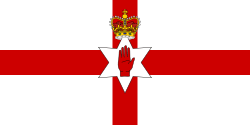


- 2008 –

- 2010 –

- 2013 –

- 2017 –

Football League 100 Legends
The Football League 100 Legends is a list of "100 legendary football players" produced by The Football League in 1998, to celebrate the 100th season of League football. Eight former Derby players made the list.
The Jack Stamps Trophy (Player of the Year)
Derby County's Player of the Season award is voted for by the clubs supporters and named in honour of Jackie Stamps, who scored two goals in Derby's sole FA Cup final victory in 1946. It was first introduced in the 1968–69 season.[57]
Managers
Below is a list of all the permanent managers that Derby County have had since the appointment of Harry Newbould in 1900.[59] In the 16 years prior to Newbould's appointment, the team was selected by club committee, a standard practice by football clubs at the time. The current manager is Frank Lampard, who was appointed on 31 May 2018.
|
|
|
|
Current first team management
Manager: Frank Lampard
Assistant Manager: Jody Morris
First Team Coach: Chris Jones
Goalkeeping Coach: Shay Given
Head of Performance Analysis: Stephen Rands
Fitness Coach: Steve Haines
Head Physio: Robin Sadler
Board of directors and ownership
- Owner and Chairman: Mel Morris
- CEO: Stephen Pearce
- Operations Director: John Vicars
- Chief Financial Officer: Stephen Pearce
- Commercial Director: Lisa Biesty
- Human Resources Director: Sarah Edwards
- Chief Technical Officer: Stuart Fisher
- Honorary Vice Chairman: Don Amott
- Club Ambassadors: Roy McFarland, Roger Davies, Michael Johnson
Club academy
Moor Farm
Derby County's academy, called Moor Farm, is a purpose-built complex situated near the city suburb of Oakwood. It was built in 2003, at a cost of £5 million,[60] to replace the club's previous academy, The Ram-Arena, which was based at Raynesway. It covers 50 acres (200,000 m2) and features six full-sized training pitches plus an indoor pitch and includes a gym, restaurant, ProZone room and a laundry.[60] When opening the academy, then-Chairman Lionel Pickering said that the intent was to have "at least eight players from the Academy... in the first-team within three years."[60] Although this was not achieved, the academy produced a number of notable players, including England international midfielder Tom Huddlestone, Wales international defender Lewin Nyatanga, Northern Ireland international goalkeeper Lee Camp, England under-21s players Miles Addison and Lee Grant, as well as England under-19 player Giles Barnes.
In April 2009, new manager Nigel Clough announced his intention to restructure the academy, appointing former Derby players Darren Wassall and Michael Forsyth[61] and Wolverhampton Wanderers Academy director John Perkins to the backroom staff, replacing the departed Phil Cannon, David Lowe and Brian Burrows.[62] Following this, and an increased investment of £1 million per year from the club,[63] a number of players broke through to the first team squad; ahead of the 2010–11 season, almost a third of the Derby squad were academy graduates, with Mason Bennett setting the club record for youngest first team appearance when he made his full debut with a start in a defeat at Middlesbrough on 22 October 2011 at the age of 15 years and 99 days old.[64] This helped strengthen the academy's reputation[65] and reinforced CEO Tom Glick's stated desire to make Moor Farm "the academy of choice in the Midlands."[65] In August 2012, Derby's academy became a tier 2 academy under the new controversial Elite Player Performance Plan.[66] It was awarded Tier 1 status two years later in July 2014.[67]
Honours
Note: the leagues and divisions of English football have changed somewhat over time, so here they are grouped into their relative levels on the English football league system at the time they were won to allow easy comparison of the achievement
Domestic honours
- Premier League and predecessors (level 1 of the English football league system)
- Football League Championship and predecessors (level 2 of the English football league system)
- Football League One and predecessors (level 3 of the English football league system)
- FA Cup
- Winners: 1946
- FA Charity Shield
- Winners: 1975
Minor honours
- Texaco Cup
- Winners: 1972
- Watney Cup
- Winners: 1971
- Anglo-Italian Cup
- Runners-up 1992–93
Reserve team honours
125th anniversary
As part of the club's 125th Anniversary in 2009, the Derby board took a number of initiatives to celebrate the club's history.
All-time XI
As part of the club's 125th Anniversary celebrations,[69] it was announced that during 2009 each month a vote would be carried out to decide on the club's official All Time XI, starting in February 2009 with the goalkeeper, with the following eight months offering opportunities for Derby's support to select a team based within a 4–4–2 formation, with December's vote being reserved for the manager.[70] Voting closed on the 25th of each month, with the winner being announced in the following few days.[71]
| Player | Position | Years at Club |
|---|---|---|
| Colin Boulton[72] | Goalkeeper | 1964–78 |
| Ron Webster[73] | Right back | 1960–78 |
| David Nish[74] | Left back | 1972–79 |
| Roy McFarland[75] | Centre Back | 1967–81; 83–84 |
| Igor Štimac[75] | Centre Back | 1995–99 |
| Stefano Eranio[76] | Right Wing | 1997–2001 |
| Alan Hinton[77] | Left Wing | 1967–75 |
| Archie Gemmill[78] | Centre midfielder | 1970–77; 82–84 |
| Alan Durban[78] | Centre midfielder | 1963–73 |
| Steve Bloomer[79] | Centre forward | 1892–1906;10–14 |
| Kevin Hector[79] | Centre forward | 1966–78; 80–82 |
| Brian Clough[80] | Manager | 1967–73 |
Top 10 Derby goals
On 2 June 2009, the Club announced the supporters choice of the Top 10 Goals in the club's history, with the fans then asked again to choose their favourite from the 10 nominated. The list was obviously biased in favour of more recent goals, largely thanks to the increased coverage modern football enjoys. Three goals featured from the club's 2008/09 campaign.[81] The winners were announced on 22 June 2009.[82]
| No. | Player | Opponent | Year | Competition | % of vote |
|---|---|---|---|---|---|
| 1 | Manchester United | 1997 | FA Premier League | 39.3% | |
| 2 | Real Madrid | 1975 | European Champions Clubs' Cup | 25.4% | |
| 3 | Crystal Palace | 1996 | Football League Division One | 10% | |
| 4 | West Brom | 2007 | Football League Championship Playoff Final | 6% | |
| 5 | Liverpool | 1972 | Football League Division One | 4.4% | |
| 6 | Manchester United | 2009 | Football League Cup | 4.4% | |
| 7 | Nottingham Forest | 2009 | FA Cup | 4.2% | |
| 8 | Rotherham United | 1986 | Football League Division Three | 3.1% | |
| 9 | Chelsea | 1968 | Football League Cup | 2.2% | |
| 10 | Doncaster Rovers | 2009 | Football League Championship | 1% |
Derby County in Europe
Derby first competed in Europe when they entered the 1972–73 European Cup after winning the 1971–72 First Division Title,[83] reaching the semi-final stages, where they lost 3–1 on aggregate to Juventus in controversial circumstances. They had qualified for the 1970–71 Fairs Cup after finishing the 1969–70 First Division in 4th, but were banned from entering the competition for financial irregularities. The 70s was the Derby County’s peak in English football and they qualified for Europe in three of the next four seasons, competing in the UEFA Cup or the European Cup in each of the three seasons between 1974–75 and 1976–77.
The club then declined rapidly and has not appeared in the top European competitions since, though it finished in 5th in the 1989 First Division which would have guaranteed entry into the 1989–90 UEFA Cup had English Clubs not been banned from Europe following the Heysel Stadium Disaster.
Outside of major competition, the club competed in the Anglo-Italian Cup between 1992–93 and 1994–95, reaching the final in 1993, losing 3–1 to Cremonese at Wembley.
Records and statistics
Kevin Hector holds the record for Derby County appearances in all competitions, appearing 589 times in two separate spells with the club between 1966 and 1982. He sits ahead of Ron Webster, who played 535 times for the club, often in the same team as Hector. Just counting league appearances, Hector is again in the lead with 486 appearances, ahead of Jack Parry, who played 483 times for the club between 1948 and 1967.
The club's all-time top goalscorer is Steve Bloomer, often referred to as "Football's First Superstar", who netted 332 goals for the club in two spells between 1892 and 1914. He is over 100 goals ahead of second in the list Kevin Hector, who netted 201 goals for the club. Jack Bowers holds the club record for most goals in a single season, when he scored 43 goals (35 in the league and a further 8 in the FA Cup), during the 1932–33 season.
The club's record attendance is 41,826, for a First Division match against Tottenham Hotspur at the Baseball Ground on 20 September 1969, which Derby won 5–0. The record is unlikely to be broken in the near future as Derby's current stadium, Pride Park Stadium, has a limit of 33,597 spectators. The record attendance at Pride Park for a competitive Derby County match is 33,378 for a Premier League match against Liverpool on 18 March 2000. The largest crowd to ever watch a Derby County game is 120,000 when Derby County played Real Madrid at the Santiago Bernabéu Stadium in the 1975–76 European Cup.
Derby's historically poor 2007–08 Premier League campaign saw the club set and equal several unwanted records in English football. The club equaled Loughborough's all-time league record of just one win in an entire league season. They also equaled or set several Premier League records (1992–present), including fewest home wins in a season (1, joint with Sunderland), fewest away wins in a season (0, joint with five other clubs), and most defeats in a season (29). Records set included fewest points in a season (three points for a win) with 11; fewest goals scored (20), and worst goal difference (−69).[84] The club also holds the record for most consecutive league games without a win, with 36 matches over two seasons between 22 September 2007 and 13 September 2008.
Derby also own the record for most lopsided defeat in an FA Cup final, a 6–0 loss to Bury in the 1903 final.[85]
See also
Derby County L.F.C. – Women's football club associated with Derby County F.C.
References
- ↑ "Europe's club of the Century". International Federation of Football History & Statistics. Retrieved 10 September 2009.
- ↑ "The Derby Ram, 1867". Folkplay. 28 June 2004.
- ↑ "Nottingham Forest 3 – 1 Derby County". facupfinals.co.uk. 16 April 1898. Archived from the original on 28 September 2011. Retrieved 30 October 2013.
- ↑ "Sheffield United 4 – 1 Derby County". facupfinals.co.uk. 15 April 1899. Archived from the original on 28 September 2011. Retrieved 30 October 2013.
- ↑ "Bury 6 – 0 Derby County". facupfinals.co.uk. 18 April 1903. Archived from the original on 4 August 2008. Retrieved 30 October 2013.
- 1 2 3 4 5 6 7 8 "The History of Derby County Football Club". Derby County F.C. Retrieved 30 October 2013.
- ↑ "FA Cup Winners 1946". Derby County F.C. 26 March 2009. Archived from the original on 1 September 2009. Retrieved 30 October 2013.
- ↑ "Rams Name The Date For Clough/Taylor Reveal". Derby County F.C. 27 August 2010. Archived from the original on 24 October 2010. Retrieved 30 October 2013.
- ↑ "Baseball Ground sculpture has been unveiled". ThisIsDerbyshire. Archived from the original on 5 November 2014. Retrieved 30 October 2013.
- ↑ New Derby chairman backs Davies BBC Sport Online
- ↑ Billy Davies leaves Derby by mutual consent The Times
- ↑ Giles Mole and agencies (28 November 2007). "Paul Jewell appointed Derby manager". Telegraph.co.uk.
- ↑ McNulty, Phil (29 March 2008). "Derby 2–2 Fulham". BBC Sport. Retrieved 29 March 2008.
- ↑ "Dismal Derby take Cats' sad place in the record books". Sunderland Echo. 29 March 2008. Retrieved 31 October 2013.
- ↑ "New owners reveal Derby ambition". BBC Sport. 28 January 2008. Retrieved 31 October 2013.
- ↑ "Jewell resigns as Derby manager". BBC Sport.
- ↑ "Clough takes over as Derby boss". BBC Sport. 6 January 2009. Retrieved 31 October 2013.
- ↑ "Derby County". Historical Football Kits. Retrieved 31 October 2013.
- ↑ "New green Rams away kit revealed". Soccerlens. Retrieved 31 October 2013.
- ↑ "Stars in stripes". Derby County F.C. 30 August 2008. Archived from the original on 1 March 2010. Retrieved 31 October 2013.
- ↑ "Rammie". Derby County F.C. Archived from the original on 2 November 2013. Retrieved 31 October 2013.
- ↑ "Rammie sets example with pledge for 2007". therams.co.uk. Archived from the original on 11 July 2007. Retrieved 31 October 2013.
- 1 2 "Reading with Rammie". film-studios.co.uk. Archived from the original on 13 February 2007. Retrieved 31 October 2013.
- ↑ "Rammie Read's Aesops Fables [DVD]". Amazon. Retrieved 31 October 2013.
- ↑ "Rammie Fan Club". Retrieved 12 June 2008.
- ↑ "Brave Mum realises Rammie dream". Derby County F.C. 9 December 2007. Archived from the original on 16 May 2009. Retrieved 31 October 2013.
- ↑ "Derby County: Rams supporters welcome home Ewie – can you spot yourself with Rammie?". Derby Telegraph. Archived from the original on 5 October 2015. Retrieved 1 December 2015.
- ↑ "1886 – Blackburn Rovers". facupfinals.co.uk. Archived from the original on 28 September 2011. Retrieved 31 October 2013.
- 1 2 3 Culley, Jon (10 May 1997). "Derby's muddy oasis of sulphur and spectacle". The Independent. London. Retrieved 1 May 2010.
- ↑ "Proposed new Derby County stadium 1945". Footysphere. Retrieved 8 February 2017.
- ↑ , England AFC. Retrieved 31 October 2013
- ↑ "Pride Park Stadium". Football Ground Guide. 10 June 2008. Archived from the original on 26 August 2012. Retrieved 31 October 2013.
- ↑ "The Coffee Horror Show". BBC. 22 March 2004. Retrieved 10 June 2008.
- ↑ Lacey, David (10 June 2008). "Passion undimmed is sole solace for doomed Derby". The Guardian. London. Retrieved 31 October 2013.
- ↑ "RamsSpace Goes Nuts". ramspace. Archived from the original on 21 August 2009. Retrieved 31 October 2013.
- ↑ "And our survey says..." Sky Sports. British Sky Broadcasting. 25 July 2008. Retrieved 14 June 2012.
- ↑ "Derby County's Nick Webster is npower Championship Fan of the Year". The Football League. 24 March 2013. Archived from the original on 1 May 2013. Retrieved 25 April 2013.
- ↑ "Premier League Attendance 2007–08". Soccernet. Retrieved 31 October 2013.
- ↑ "Coca-Cola Football League Championship Attendance 2008–09". itv.stats. Archived from the original on 2 November 2013. Retrieved 31 October 2013.
- ↑ "Coca-Cola Football League Championship Attendance 2009–10 inclusive". stats.football365.com. Archived from the original on 2 November 2013. Retrieved 31 October 2013.
- ↑ "Rams fan Niall scores X-Factor place as part of One Direction". Derby Telegraph. Northcliffe Media. 13 December 2010. Archived from the original on 11 October 2014. Retrieved 31 October 2013.
- ↑ Gourlay, Dom. ""There's no point in touring with a band if you're playing music that you hate": DiS meets Graham Co". DrownedInSound.
- ↑ "VIVA Interview: Garry Hayes (The Gaslight Anthem)". VIVA Lifestyle Magazine. 2014-11-17. Retrieved 2017-03-25.
- ↑ https://www.derbytelegraph.co.uk/news/celebs-tv/keiran-lee-britains-top-porn-189114
- ↑ "Jack O'Connell Named As Derby County's 2014/15 Designated Charity Ambassador". DCFC Media.
- ↑ "Derby County: George Clooney invited to Rams match after reportedly becoming a fan". Derby Telegraph. Archived from the original on 8 December 2015. Retrieved 1 December 2015.
- ↑ "Angelina Jolie: Hollywood actress now a Derby County fan after filming with Alvaston's Jack O'Connell". Derby Telegraph. Archived from the original on 8 December 2015. Retrieved 1 December 2015.
- ↑ "Which club does model Cara Delevingne support?". Daily Mirror. Retrieved 1 December 2015.
- 1 2 "Club Rivalries Uncovered" (PDF). Football Fans Census. December 2003. Archived from the original (PDF) on 20 October 2013. Retrieved 31 October 2013.
- ↑ "Archived copy". Archived from the original on 10 February 2012. Retrieved 17 December 2009. , Football Fever – Rivalries. Retrieved 9 April 2008
- ↑ Hamilton, Duncan (11 January 2009). "Nigel Clough: father's pride". The Times. London. Retrieved 15 January 2010.
- 1 2 "Derby County". You and Yesterday. 8 December 2009. Archived from the original on 17 December 2009. Retrieved 31 October 2013.
- ↑ "First team". dcfc.co.uk. Derby County FC. Retrieved 26 July 2017.
- ↑ https://www.dcfc.co.uk/news/2018/01/derby-swoop-to-sign-frontman-jerome
- ↑ "Why Richard Keogh was not handed back the captain's armband in Derby County's defeat by Middlesbrough". April 23, 2018. Retrieved April 23, 2018.
- ↑ "Hall of Fame – National Football Museum". National Football Museum. Retrieved 31 October 2013.
- ↑ "Player Of The Year". DCFC Media.
- ↑ "Keogh Wins The Jack Stamps Trophy". Derby County F.C. 4 May 2013.
- ↑ "Roll- Call of Managers". Derby County F.C. Archived from the original on 2 November 2013. Retrieved 31 October 2013.
- 1 2 3 "Down on the farm". BBC Sport. Retrieved 12 June 2008.
- ↑ "Ex-Rams given academy roles". Derby Telegraph. Archived from the original on 23 September 2015. Retrieved 31 October 2013.
- ↑ "Academy exit for cannon". Derby Telegraph. Archived from the original on 23 September 2015. Retrieved 31 October 2013.
- ↑ "Rams confident their academy can compete with best under redrawn rules". thisisderbyshire. 31 October 2013. Archived from the original on 31 October 2013.
- ↑ "Teams news: Bennett to make Rams history at Boro". thisisderbyshire. 31 October 2013. Archived from the original on 31 October 2013.
- 1 2 "Glick says Academy aims to be Midlands beacon". thisisderbyshire. 7 December 2011. Archived from the original on 31 October 2013.
- ↑ "Derby To Compete in New U21 League". Derby County F.C. 6 August 2012.
- ↑ "Derby County awarded category one academy status". BBC Sport. 26 July 2014.
- ↑ "Derby County Club Honours – Derby County". www.dcfc.co.uk.
- ↑ "LEGENDS UNITE TO CELEBRATE 125". Derby County F.C. Retrieved 31 October 2013.
- ↑ "Derby County Football Club 125th Anniversary". therams.co.uk. Archived from the original on 6 February 2009. Retrieved 31 October 2013.
- ↑ "Keeper voting is now closed". Derby County F.C. Retrieved 31 October 2013.
- ↑ "Top keeper poll-winner Boulton thanks fans". Derby Telegraph. Archived from the original on 31 October 2013. Retrieved 31 October 2013.
- ↑ "Webster the right choice". Derby Telegraph. Archived from the original on 24 September 2015. Retrieved 31 October 2013.
- ↑ "NISH IS LATEST ALL-TIME XI INDUCTEE". Derby County F.C. Retrieved 31 October 2013.
- 1 2 "Vote pairs Roy, Igor at heart of all-time top team's defence". Derby Telegraph. Archived from the original on 24 September 2015. Retrieved 31 October 2013.
- ↑ "Eranio proves to be right choice as he is included in the all-time greats team". Derby Telegraph. Archived from the original on 2 April 2015. Retrieved 31 October 2013.
- ↑ "HINTON MAKES ALL-TIME XI". Derby County F.C. Retrieved 31 October 2013.
- 1 2 "GEMMILL & DURBAN NAMED IN ALL-TIME XI". Derby County F.C. Retrieved 31 October 2013.
- 1 2 "Greatest XI Line-Up Complete". Derby County F.C. Retrieved 31 October 2013.
- ↑ "Derby County's All-Time XI". Derby County F.C. Retrieved 31 October 2013.
- ↑ "The Final Countdown". Derby County F.C. 4 June 2009. Archived from the original on 5 June 2009. Retrieved 31 October 2013.
- ↑ "Wanchope is the winner". Derby County F.C. Retrieved 31 October 2013.
- ↑ "The Rams in Europe". thisisderbyshire.co.uk. Archived from the original on 26 September 2011. Retrieved 31 October 2013.
- ↑ "For the record: Premier League facts and figures (current through 10/12/2017)". Premierleague.com. Retrieved 16 December 2017.
- ↑ Statistics taken from Rothman's Football Yearbook 2008.
Derby County Poem by Martin Ward, published in Derby Telegraph 9/10/2018, on free website Poemhunter.com
External links
| Wikimedia Commons has media related to Derby County F.C.. |
- DCFC.CO.UK – Official Site
- Official Derby County F.C Fan Engagement Site
- Derby County Fans Online
- TheRams.co.uk – Derby Evening Telegraph Rams site.
- BBC Sport Derby County – BBC's Derby County section.
